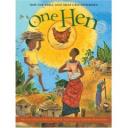One Hen: How one small loan made a big difference written by Katie Milway and illustrated by Eugenie Fernandes is an inspiring true story about a young boy from Ghana who takes out a small loan and ends up with a thriving farm.
The story begins with Kojo’s hen, the first thing he buys with the loan money. Soon, he began selling the eggs from the hen in order to purchase additional hens. He takes the money he earns from the hens and starts saving it to attend school. After college, he begins a farm and raises a family of his own. His farm grows into a wealthy investment and he is then able to lend money out to others. Kojo never forgets that his good fortune and determination began “with a good idea and a small loan that made it come true. It all started with one brown hen”.
Curriculum Connections:
One Hen: How one small loan makes a big difference could be used as an introduction to the concepts of loans and saving money. It could also aid with teaching students about economic choice. This book can be used for SOL’s such as: 3.9 – The student will identify economic choice and explain opportunity cost.
One Hen: This is the official website for the book. You can find quizzes for the book, printable poster for the classroom, lesson plan ideas, interactive games for students, and activities for different age groups and content areas. It is a kid friendly site, good for the classroom.
Learning Resource Material: This is a PDF from Kids Can Press that has an overview of the book and provides activities for young readers and older readers.
Microfinance for Kids! A PDF newsletter that explains what microfinance is to children. It even introduces children to the real Kojo and talks about his life.
General Information:
Book: One Hen: How one small loan made a big difference
Author: Katie Milway
Illustrator: Eugenie Fernandes
Publisher: Kids Can PressPublication
Date: February 2008
Pages: 32
Grade Range: 3-5
ISBN-10: 9781554530281

